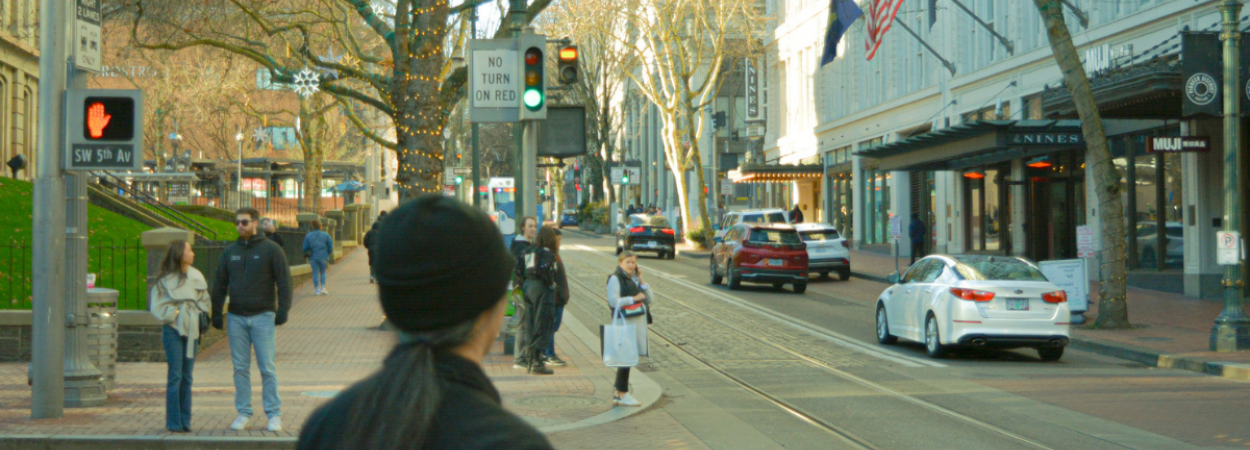Friday Transportation Seminars at Portland State University have been a tradition since 2000. We've opened up PSU Transportation Seminars to other days of the week, but the format is the same: Feel free to bring your lunch! If you can't join us in person, you can always watch online via Zoom.
PRESENTATION ARCHIVE
THE TOPIC
The Portland Bureau of Transportation (PBOT) was awarded a nearly $2 million Strengthening Mobility and Revolutionizing Transportation (SMART) Grant by the US Department of Transportation (USDOT) in Fall 2023 to pilot the country’s first regulated Zero-Emission Delivery Zone in downtown Portland and test digital infrastructure tools. This project will test an innovative set of incentives and regulations to better understand what technology and strategies municipalities can use to support and reduce greenhouse gas emissions in the freight sector.
While other cities in the United States have piloted voluntary Zero-Emission Delivery Zones (ZEDZs) to encourage the transition of commercial fleets to zero-emission modes, Portland is the first U.S. city to pilot a regulated ZEDZ. The regulated ZEDZ will be active during a demonstration period of approximately six months beginning in late summer/early fall of 2024. During this temporary demonstration period, the parking rules for all truck loading zones within the project area will be changed to prioritize access for zero-emission vehicles only.
This pilot project will also test a variety of partnerships and incentives to accelerate the movement of “clean goods.” This could include diverting existing deliveries into the ZEDZ to local fleets of electric-assist cargo trikes and electric vehicles, vans and trucks, or supporting local delivery companies in transitioning their own fleets to zero-emission modes.
KEY LEARNING OUTCOMES
- Existing approaches to curb management in a dense urban environment, including how data provides new insights into innovative City strategies.
- How the City is looking ahead to remove barriers to access for industry who have sustainability commitments but face operational challenges.
- Communities’ response to zero-emission delivery and the benefits of expanding transportation decarbonization solutions.
SPEAKERS
Art Pearce, Planning, Programs, & Projects Deputy Director, Portland Bureau of Transportation
Art Pearce (he/him) is an experienced urban innovator with an extensive background in broad public-private collaborations utilizing transportation investment and mobility innovations to shape the future of cities. He has 26 years of experience envisioning and driving change in Portland’s transportation system: establishing policy, planning and delivering transformative investments, and overseeing people-based behavior change and mobility programs. He has a deep understanding of the challenges cities and city governments face in propelling change at an adequate pace, and the new imperatives presented by the crises of climate, and social and racial equity.
Sarah Pullman, Transportation Planner, Portland Bureau of Transportation
Sarah Pullman (she/her) brings over five years of experience in project management, urban design, public engagement, and planning policy. Sarah has a strong background in research and analysis and is quick to learn and adapt to innovative approaches for sustainable and equitable planning. Her mission is to ensure everyone can move around safely and sustainably regardless of their zip code, language spoken, race, and gender. At the City, Sarah has been leading the day-to-day work for the SMART Stage 1 project. She is responsible for cross-bureau collaboration, external stakeholder communication, digital permit launch, sensor installation, and more.
Jacob Sherman, Mobility Innovations Program Manager, Portland Bureau of Transportation
Jacob Sherman (he/him) brings more than 16 years’ experience managing innovative programs, projects, and partnerships to the City. His team focuses on shared mobility, policy on transportation technologies, and driving action on transportation electrification, which is core to the City’s climate goals. Before joining PBOT, he worked at the Portland Bureau of Housing, managing a complex and controversial multiagency project sponsored by the Oregon Governor’s Office. He has co-edited two books on city-university partnerships, written articles, delivered numerous conference presentations, and lectured for the U.S. Fulbright Program.
PROFESSIONAL DEVELOPMENT
This 60-minute seminar is eligible for 1 hour of professional development credit for AICP (see our provider summary). We can provide an electronic attendance certificate for other types of certification maintenance.
Portland State University's Transportation Research and Education Center (TREC) is a multidisciplinary hub for all things transportation. We are home to the Initiative for Bicycle and Pedestrian Innovation (IBPI), the data programs PORTAL and BikePed Portal, the Better Block PSU program, and PSU's membership in PacTrans, the Pacific Northwest Transportation Consortium. Our continuing goal is to produce impactful research and tools for transportation decision makers, expand the diversity and capacity of the workforce, and engage students and professionals through education, seminars, and participation in research.

















